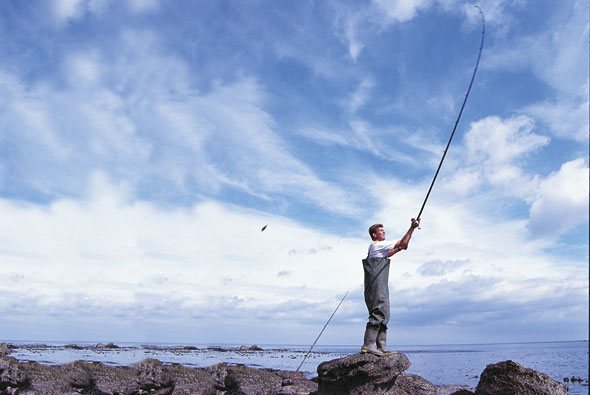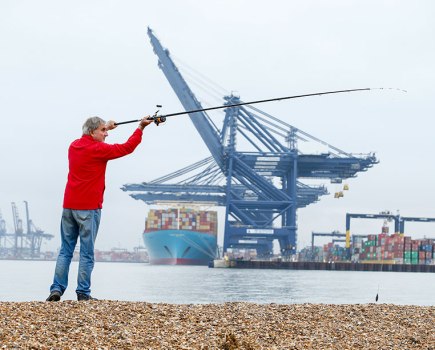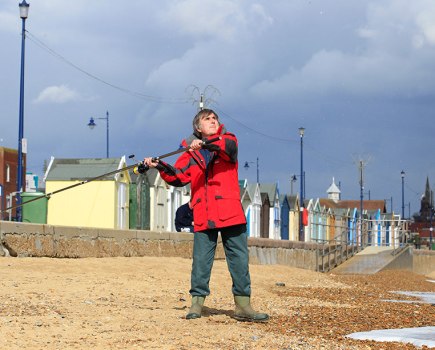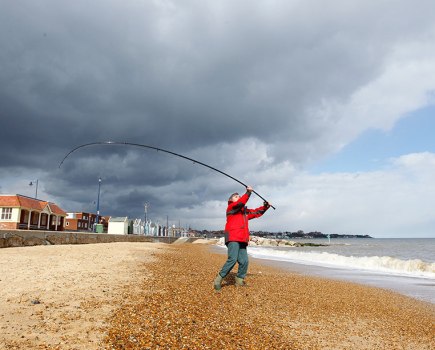It was Les Moncrieff who linked distance beach casting to cod fishing during the 1960s that sparked the UK beach fishing revolution. His Layback method and reverse taper Springheel rod delivered 6oz or 8oz of lead and a big hook-load of bait way beyond the 100 yard mark, which he regarded as the minimum distance for successful codding, says John Holden, who sets the casting scene which has lead to today’s stalemate…
You can imagine what an influence Les’s articles and demonstrations had on cod anglers who were hungry for information about anything connected with long-range fishing.
Enthusiastic about all kinds of casting, Kent-based Les was hugely encouraging to up-and-coming tournament casters like me, helping us to develop rods and casting methods that smashed record after record.
Stiff butted rods and the pendulum cast is a by-product of his pioneering work, though he was personally none too keen on either.
Ironically, it was Moncrieff’s success as a teacher that eventually helped to kill his own Layback system. The style was still as effective for long range codding as anyone could wish for, but it could not cut it on the tournament field.
It is sad that fishing rods came to be judged by their tournament casting performance, but that is life. The demoli¬tion of Layback casting by rigid rod handles, fast tips and pendulum casts was completed by the early 1970s.
The arrival of carbon fibre technology then brought us to the current state of affairs. Some say that we have reached the ultimate in rod design and casting techniques. Others, more sceptical perhaps, suggest that perhaps some aspects of fishing have been spoilt by an over-emphasis on casting.
Fast pendulum rods thrash the older rod designs over grass. But, compared with Layback and other older methods, what are the benefits of the latest kit if your casting ability is less than expert? Obsolete as they seem, reverse taper rods and even the Layback style deserve a second look.
With the majority of beach anglers still unable to cast anywhere near as far as they would like – and only a tiny minority able to reach Moncrieff’s own distances of 40 years ago – can the sport afford to ignore any system with a track record for delivering excellent distances and all-round fishing ability?
If you have trouble casting, would a slower rod and Layback-type cast add many yards and be more pleasant to handle? It would be easy to create an improved version of the Springheel action. The reverse taper design is capable of being developed way beyond that.
Other candidates for revival
Massive distances and heavy artillery do not tell the whole story of beach fishing as it evolved from Moncrieff to Mackellow, from relaxed efficiency to athletic powerhouse. Dozens of new ideas came along, mostly disappearing within a few months unless they helped in the quest for more and more distance.
Twenty-five years ago, there was a great interest in light tackle as well typified by the old Angling magazine’s campaign to bring greater finesse to sea fishing. The full story is best left to the anoraks.
 Two anglers do deserve a special mention, though. In an attempt to inject a more sporting flavour into cod fishing, the late Ian Gillespie of Breakaway Tackle and Southend tackle builder Bill Roberts came up with the lightweight Cod Pole series of beachcasters.
Two anglers do deserve a special mention, though. In an attempt to inject a more sporting flavour into cod fishing, the late Ian Gillespie of Breakaway Tackle and Southend tackle builder Bill Roberts came up with the lightweight Cod Pole series of beachcasters.
Even in 5oz spec these rods were so light and flexible that you felt that the blanks could safely be bent into a hoop. For their time they were of relatively quick action. Despite their flimsiness by today’s stan¬dards, Cod Poles delivered excellent beach distances, easily topping 150 yards.
All models made fishing hugely enjoyable because they were designed to do exactly that. Casting performance was set at “far enough” because anything more would jeopardise the rods’ other characteristics and was wasted on the beach anyway.
Nothing compares to the sheer joy of hooking a 4lb or 5lb fish on a Cod Pole. Few of today’s carbon rods rival the balance and precision of that old all-glass blank with its wire rings and minimalist handle fittings. ‘Bare Bones,’ they called them back in the glory days.
Again, it is well worth asking: Is the Cod Pole merely a footnote in angling history, or could it be resurrected as a serious player in the beach game?
Fashion is a much stronger driving force than necessity. These old rods were highly successful fishing weapons. They died because they became old hat, not because they failed to perform excellent service on the beaches.
Modern versions would be even better. Their deliberately limited performance – if you call the best part of 200 yards limited – means that they are particularly suited to practical beach fishing where 150 yards is more than enough for most people.
My view is that if the Layback or Cod Pole systems were invented today and marketed as ‘easy cast’ products, they would take the market by storm.
Pendulum casting a soft rod
Almost every rod on the market has a stiff handle and fast tip. To pendulum cast them for fishing (as opposed to tournaments), the sensible way is to build the power slowly and smoothly.
This avoids pre-loading the blank too soon in the casting arc, which is a fatal error for all but the strongest of casters. A modestly pre-loaded rod given a distinctly late hit when the arms flick over in a whip¬like action produces excellent fishing distances with the least fuss. Slow build-up, late hit is the winning formula.
Pendulum casting a soft butted rod that way gives poor distances and a plague of backlashes. This is the basis of the well known ‘fact’ that you can’t pendulum cast a soft rod at all.
So why did Cod Poles and similar old gear still produce their best performance with a pendulum style? The short answer is that it was a different version of the cast.
A soft rod pendulum needs a radically different energy flow, almost the reverse of fast rod recommendations. This is achieved by first setting the drop length and swing angle to produce high sinker inertia at the beginning of the cast. A fast rod loaded like this will make a reel spin rapidly, often out of control.
Then build the power quickly and early using shoulder rotation so that the blank is almost fully loaded at the point when the arms turn the rod over. There is no powerful late flick.
With this variation of pendulum casting, there is no need for the arms to do much more than guide the rod while it unwinds almost of its own accord. Early build up, no need to hit.
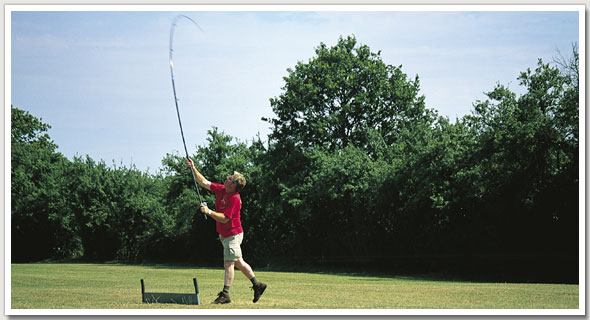
It is the big distances tournament casters have clocked up that has driven the rod building market with the result that expensive super-fast rods have become the ‘must have’ accessory on the beach. Wrong!
Discovering your own casting style
Casting is nothing more than applying a certain amount of force to a rod as it travels along a pathway of certain length and shape. Energy is drawn from the caster, stored in the rod then released to propel the sinker into the sky. Sounds complicated. It is simple if you know what goes on when your rod begins to bend – and we’ll be looking into that next month.
There are a few points you should be clear about before we start to analyse casting tech¬nique. As a prelude to mastering any particular style you will need to discover the force pattern and rod path that suits you as an individual.
That knowledge will point you towards a suitable style or styles to practise. It is an unfortunate fact of life that there will be some kinds of cast at which you will never be able to excel. The good news is that at least one style will be absolutely right for you.
We shall be looking at ways to make you more aware of this interaction between a caster and his tackle. Pendulum and other sinker-swinging methods are quite critical in their demands for correct flow and cast ‘shape’, but all styles are affected to some degree.
You really do need to discover your own natural flow and timing. The wrong choice of method and tackle might well see you fighting a losing battle no matter how hard you try.
For all levels of beach fishing, the two main options for working a rod efficiently are ‘arm casting’ and ‘body casting.’ Most casts are a combination of both actions, but one of them will tend to dominate the other.
Arms-dominant casters load the rod slowly and finish with a whip-like action. They do well with stiff butted, fast tipped rods; the slow build, late hit formula.
Body casters exploit a powerful but effortless body rotation and shoulder action that can extract a wonderful performance from softer, slower rods.
This does not mean that body casters don’t use their arms, or that arm casters don’t rely to some extent on body rotation as sources of power. What counts is the natural balance of one action to the other. Get the balance too far wrong and you will end up.
Six key casting points you must consider
● It is a myth that you can’t pendulum cast a soft rod.
● Soft pendulum rods need a radically different energy flow.
● Load fast rods the wrong way and they will rip your thumb off!
● Remember there is a casting style right for you.
● Arms-dominant casters load the rod slowly and finish with a whip-like action.
● Body casters exploit a powerful but effortless body rotation and shoulder action. quick tips

